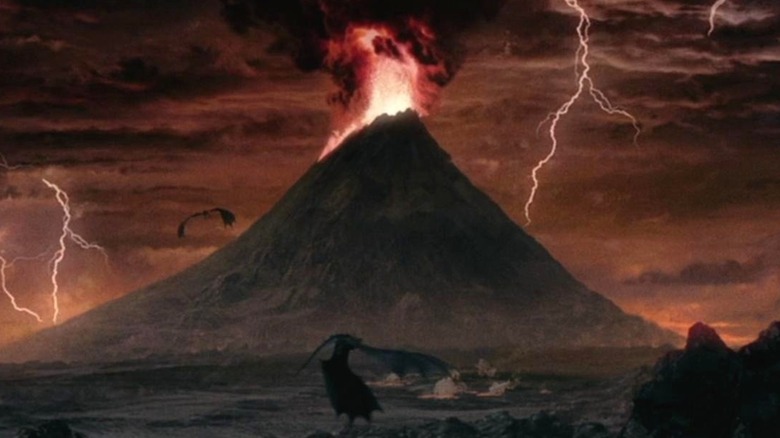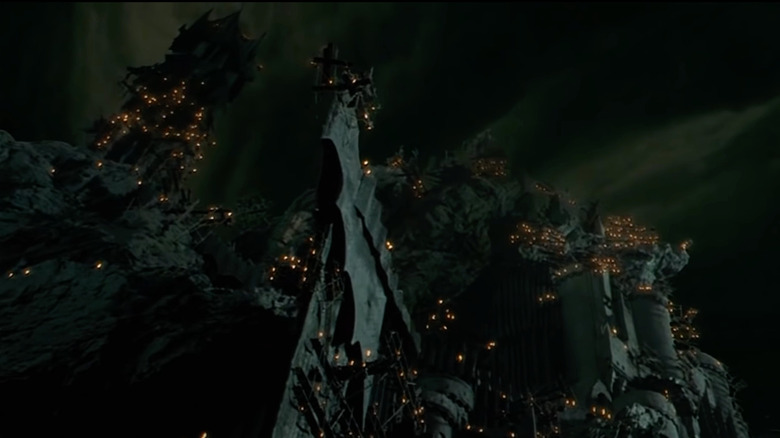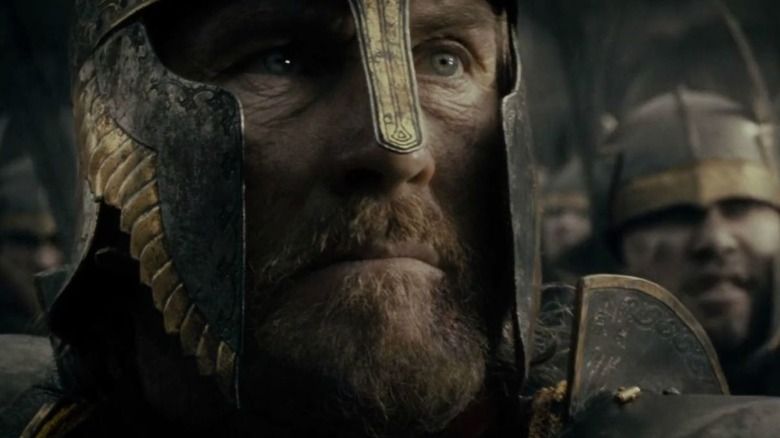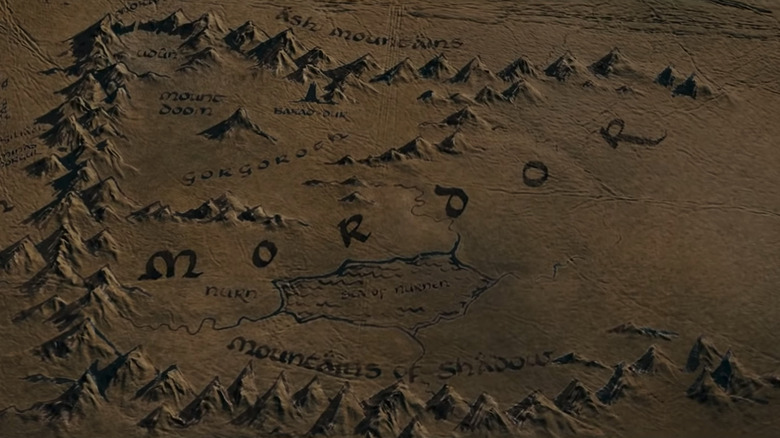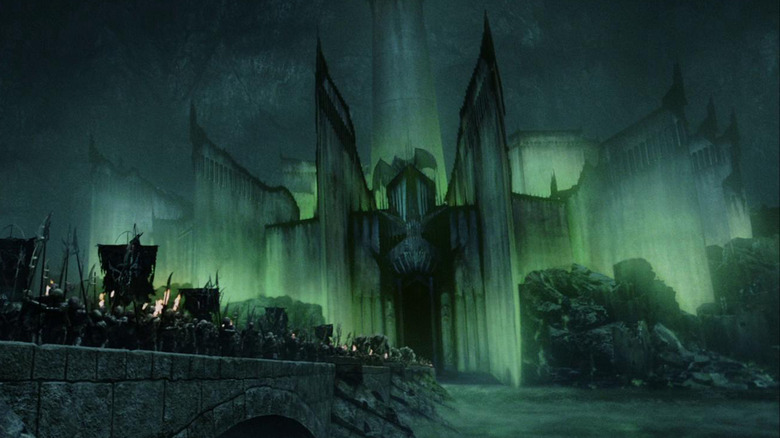Sauron's Realm Of Mordor Explained
Middle-earth is a massive place. It's filled with countless regions, nations, mountains, rivers, seas, and landmarks that all feature prominently throughout Tolkien's gargantuan stockpile of written content. While every area of Middle-earth has value in its own way, amid the general geographic bustle, there stands one area to rule them all. One nation defined by power. One region focused on domination. We're talking, of course, about Mordor.
Always uttered with a shudder, the Black Land — literally, Mordor translates from the Elvish as "The Black Land" or "The Dark Land" — is an iconic source of evil domination throughout "The Lord of the Rings." But how did this morbidly depressing region of Middle-earth come into being? Has the area always been filled with parched air and pockmarked with pits? Is there more to Mordor than an endless, industrialized moonscape seemingly inspired by the author's hellish experience in the trenches of World War I?
We decided to take a deep dive into the history of Middle-earth to figure out where this powerhouse nation started from. Not surprisingly, Sauron is at the heart of the whole ordeal, and the land follows its owner's trajectory pretty closely. However, there are also a lot of interesting twists and turns that the Land of Shadow goes through over the course of the millennia leading up to "The Lord of the Rings" – including a sizeable chunk of time when it's even controlled by Gondor.
So, without further ado, here is a brief rundown of the epic history of Middle-earth's baddest spot.
A headquarters for Sauron
Mordor is nearly synonymous with Sauron, and there's no arguing that the bulk of the history of the Black Land is closely tied to the Dark Lord's timeline. That said, though, the history of Mordor does start before Sauron ever makes it his home base. Very little is known about the area "pre-Sauron," but it appears that it was already unpleasant, and Mount Doom was busy erupting on a regular basis. In fact, in the posthumously published Tolkien book "The Peoples of Middle-Earth," Tolkien's son, Christopher, explains in a note that by the time Sauron shows up on the scene, the area may have already been called Mordor by the Elves "because of its volcano Orodruin and its eruptions — which were not made by Sauron but were a relic of the devastating works of Melkor in the long First Age."
"Melkor" is the original name of the first Dark Lord, Morgoth. This badass dude is Sauron's original master, and he dominates early Middle-earth history. When Morgoth is defeated at the end of the First Age, Sauron steps into his shoes as the new top dog. As the Second Age begins, Sauron becomes the primary antagonist of the world, but he takes his time getting some momentum. During the first centuries of that age, he doesn't seem to have a single stomping ground to call his own. However, as his enemies begin to grow, he decides to choose a headquarters for his villainous activity. The area he chooses? Mordor.
According to "The Return of the King," Sauron arrives in the Black Land around 1,000 years into the age. When he gets there, Shelob is most likely already on the premises, having arrived during the epically destructive ending of the First Age. The two agree to be non-nosey neighbors, and Sauron settles in.
Sauron is evicted
When Sauron arrives in Mordor a millennium into the Second Age, the first thing he starts doing is building a pad for himself in the form of the gigantic, terrifying tower of Barad-dûr. Fans of "The Lord of the Rings" movies might recognize the title, and yes, this is technically the name of the tower that we see the bizarrely adapted "Eye" of Sauron floating on top of in Peter Jackson's films. However, it isn't actually the same structure, as we'll see in a minute.
Sauron works on his tower for six centuries, and right around the same time that he finishes the intimidating architectural masterpiece, he also forges the One Ring in the nearby fires of Mount Doom. From there, Sauron sets out on a multi-century period of conquest, and throughout the rest of the Second Age, Mordor continues to serve as his trusty home base.
Toward the end of the age, Sauron is captured by the Men of Númenor (Aragorn's ancestors), but half a century later, he corrupts their king, destroys their island nation, and returns to Mordor, which remains critical in his plans for global domination. Soon afterward, some Númenórean survivors set up the sister kingdoms of Arnor and Gondor. Realizing that Sauron is nearby, they eventually join forces with the Elves, Dwarves, and other Free Peoples and attack Mordor itself.
This event is called the Last Alliance, and it's depicted in the opening scene of "The Fellowship of the Ring" film. It begins with the giant Battle of Dagorlad, which takes place in the same place that the Dead Marshes later occupy. After that, the good guys actually enter Mordor and besiege Sauron's castle-fortress for seven long years. At the end of that time, the Dark Lord comes out, the One Ring is cut from his finger, and he is defeated for the first time.
Mordor is empty
The defeat of Sauron at the hands of the Last Alliance leads to a gutting of the Mordor region. The land is so tainted by the Dark Lord that no one is willing to populate the area. So, instead, they build watchtowers to make sure that the region remains mostly empty of evil creatures — and so that any which remain stay well-contained in a harmless space.
Some of these watchtowers are familiar sights to fans of the story. For instance, two of them are the Towers of the Teeth that guard the Black Gate, the spot where the armies of the West attack at the end of "The Return of the King." So is the Tower of Cirith Ungol, where Frodo is held captive after his run-in with Shelob. In "The Return of the King" book, it explains that the stronghold "had been built not to keep enemies out of Mordor, but to keep them in," adding that it had been "made when, after the Last Alliance, Men of Westernesse kept watch on the evil land of Sauron where his creatures still lurked."
This watch over Mordor lasts for a very long time. The Third Age begins after Sauron is overthrown, and it isn't until halfway through the 3,000-year-long period that the Gondorian forces begin to lose their grip. Between wars and plagues, the armies of Gondor weaken, and 1,600 years into the Third Age, they abandon their guard over the Black Land. In "The Two Towers" book, it explains this event by saying that "the strength of Gondor failed, and men slept, and for long years the towers stood empty. Then Sauron returned..." Before Sauron, who had been regathering his strength away north in Mirkwood, comes home, though, he sends a welcoming party to get things ready.
Sauron comes home
Mordor sits, empty and quiet, for nearly 400 years after the Gondorians move out. However, after a few centuries, a very unpleasant group of individuals move back in: the Ringwraiths. The servants of Sauron take over the Gondorian city of Minas Ithil on the borders of Mordor and busily spend the next 1,000 years getting things in tip-top shape to throw a coming-home party for their master.
Then, after the events of "The Hobbit," Sauron leaves his stronghold in Mirkwood and returns to his old haunts in Mordor. Once back home, the Dark Lord gets right to work. He starts by rebuilding his old fortress of Barad-dûr, and a few years after his homecoming, Mount Doom also erupts back into flame, apparently unable to contain its excitement at Sauron's return.
This is also the point where we get a little bit more detail about how the rest of Mordor looks on a daily basis. In "The Return of the King," we get a brief description of how Sauron's kingdom actually runs. It explains that most of the story takes place in the industrialized north of the country, where mines, forges, and military garrisons are the focus — hence the bleak, cheerless feel of the landscape.
However, in the south, things are a bit more rural, even if they're still just as depressing. The book explains that there are many "great slave-worked fields away south, beyond the fumes of the Mountain by the dark sad waters of Lake Núrnen." It also talks about "great roads" that bring "long waggon-trains of goods and booty and fresh slaves" from tributary lands in the east and south of Mordor — areas that Sauron had conquered long before. From pernicious industry to egregious agriculture, tyrannical tribute to military might Mordor is a seriously bustling dictatorship when "The Lord of the Rings" begins.
Mordor finally falls ... again
Everyone and their mother know what happens next. Against all odds, the Free Peoples of Middle-earth defeat Sauron. Once the One Ring is destroyed, the Dark Lord's servants scatter, and the region instantly loses its superpower status.
However, that doesn't mean it goes back to the way it was the first time Sauron was overthrown. That time, Gondor set up watchtowers to watch the land — all of which collapse in ruin when the One Ring is destroyed, by the way. This time, as the Fourth Age of Middle-earth begins, the newly minted King Aragorn decides to take a more merciful approach to the situation.
"The Return of the King" explains that "the slaves of Mordor he released and gave to them all the lands about Lake Núrnen to be their own." Along with this, Aragorn makes some savvy moves with Mordor's previous allies. He releases all of his captives that are from the south and east of Mordor and makes peace with those nations wherever he can. This helps deflate the threat that Mordor poses, as it can no longer ask for the military help of its neighbors.
And it's here that the story ends, as does Mordor's. It's worth noting, though, that at one point, Tolkien began to write a sequel to "The Lord of the Rings" titled "The New Shadow." While it never got very far, one can't help wondering if Mordor would have, once again, been the battleground of choice. Then again, as with so many other areas of Tolkien's world, chances are that, without Sauron around to inhabit it, Mordor would have been left alone as an antiquated region fallen from its heady days as a central force in Middle-earth politics.
